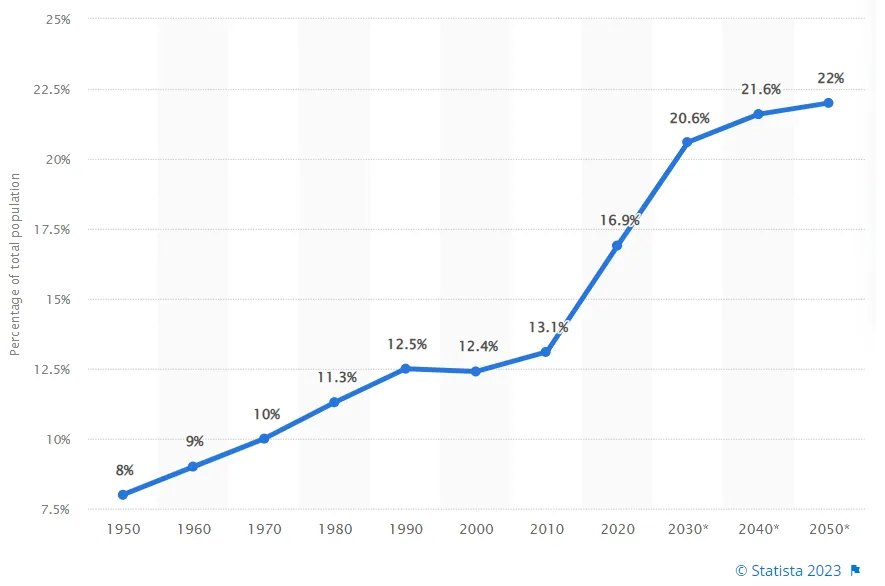Right now, there are more than 56 million seniors (aged 65+) living in the U.S. This number is expected to continue growing as the baby boomer generation ages into older adulthood. By 2030, an estimated 73.1 million will be aged 65 or older. By 2050, this number will hit 85.7 million and seniors will account for roughly 22% of the overall U.S. population.

As the senior population continues to grow, so does the cost of caring for them. The current shortage of caregivers, coupled with the increasing number of seniors choosing to age in their own homes, has put a strain on healthcare resources. As a result, many providers are turning to technological solutions like artificial intelligence.
Four Ways AI Is Enhancing Senior Care
Here are some of the ways healthcare providers are using AI to deliver better care to seniors while mitigating medical costs.
Wearable Sensors
Seniors are at a higher risk of medical emergencies like falls, strokes, and heart attacks, especially when they’re living on their own. Wearable sensors allow caregivers to remotely monitor the activities of their charges. And when paired with intelligent guardian software, these sensors can actually help caregivers prevent serious problems before they occur.
Most smartwatches (like the Apple Watch, for example) have built-in functionality to monitor heart rate, glucose levels, and other vital physiological signs. They also come with a sophisticated fall detection feature that can alert the caregiver if a senior takes a tumble.
When these sensors are used in conjunction with predictive analytics technology, they become even more powerful in terms of preventing serious risks before they can escalate. Wearable sensors can let caregivers know if their patients are missing meals, spending too much time in bed, or having trouble sleeping. By responding to these alerts in a timely and appropriate manner, caregivers can proactively deal with potential issues such as dementia, depression, malnutrition, or UTIs.
Smart Home Hubs
Smart home hubs are similar to wearable sensors, except they’re installed in the homes of seniors to ensure their safety and wellness through remote monitoring.
A smart home hub can alert a caregiver if senior patients change up their routine or behave in a way that’s unusual. These hubs also include a number of home safety features, such as keeping the thermostat at a comfortable level, automatically turning lights off and on, and locking doors.
Smart Implants
Smart implants are sensors that are embedded in the body to help seniors better manage their health. These implants provide immediate feedback to caregivers, thus ensuring medical care can be given immediately when required. As with wearable sensors, smart implants can also be paired with predictive AI to identify and address potential issues before they reach crisis level.
Many smart implants are designed to help monitor and treat chronic conditions. Glucose sensors, for example, can be used to track diabetic seniors and preemptively diagnose potential complications (such as heart disease, kidney disease, and stroke), while heart monitors can detect the risk of arrhythmias (irregular heartbeats).
Smart implants are also used to help physicians monitor and diagnose orthopedic inflictions (such as bone fractures, arthroplasty, and the displacements of bones, joints, tendons, and ligaments). These types of implants are most often used to help with the rehabilitation of physical injuries after surgery.
Robot Home Assistants
According to a 2020 Pew Research Center study, 37 percent of senior citizens in the United States live on their own. The virtual home assistant was developed to provide them with daily assistance and monitoring, as well as companionship.
Housed in robotic bodies, the home assistants allow seniors to live independently while keeping them engaged with the world around them. They provide scheduled reminders to ensure seniors take their prescribed meds, drink plenty of water, don’t skip meals, etc. Some, such as Mabu from Catalia Health, also allow their users to seek medical advice or record their physiological data through apps, text messaging, or other interfaces.
These robots also use AI to develop customized interactions with their patients, engaging them in individually tailored conversations that are specific to their needs. This might include discussing news and current events, offering up curated videos and music, or even playing games.
TLDR
The cost of in-home care will continue to rise along with the life expectancy of seniors. AI technology is improving the lives of users by ensuring they get the care they need while helping physicians and caregivers to deliver better service, all while reducing the costs associated with in-home medical care. Remote monitoring, when paired with predictive data analysis, can help caregivers anticipate and proactively address the needs of their patients.
